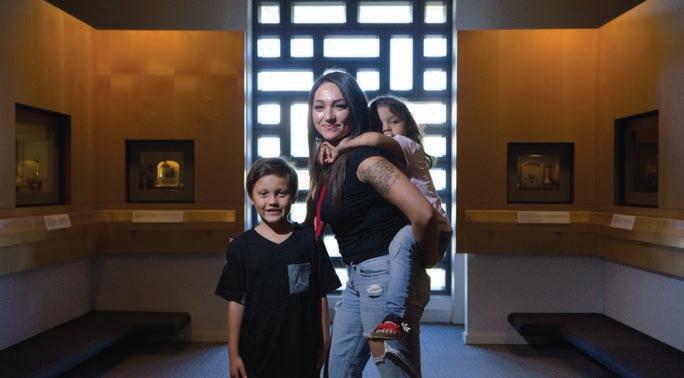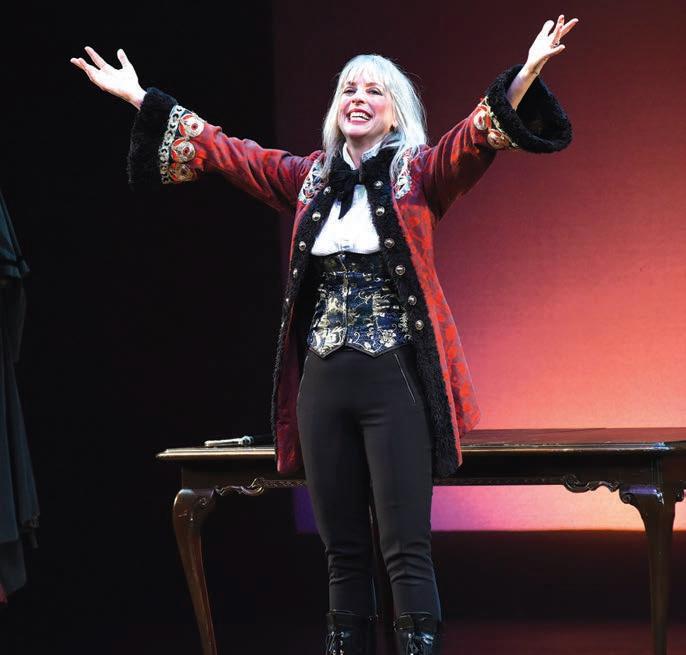
19 minute read
ARTS
THE ENTERTAINER! MAGAZINE DECEMBER 2020
ARTS
CULTURE » THEATER » DANCE » GALLERY » DRAMA » VISION
HISTORY ON FILM Phoenix Art Museum celebrates six decades with short movies
By Laura Latzko
Many people, pieces of art and events have helped to shape the Phoenix Art Museum during its 61-year history, and this trend continues.
To celebrate its six decades, the Phoenix Art Museum teamed up with local filmmakers Chris Heck, Kieran Thompson and Josh Gonzales to produce the shorts “The First Time,” “Wish You Were There” and “Represent.” The project was supported with funding from the Steele Foundation to enhance the museum’s digital media offerings.
“The First Time” was released through the museum’s website and digital media channels. The other two films will be available for view in December and February.
“The First Time” was written by Nikki DeLeon Martin, the museum’s chief marketing and external affairs officer, and directed by Heck.
“Wish You Were There” was written Heck and directed by Thompson. And “Represent” was written and directed by Heck.
Heck has worked on many commercials and TV and film projects, including the TV miniseries “Crossroads” and the short films “Mr. Memento,” “The Alchemist of Montenegro,” “Stay Home” and “The Devil’s Pawn.”
DeLeon Martin is a fiction writer and playwright whose work has been performed by local theater companies.
Most of the directors, writers, actors, editors and crew members who worked on the films are based out of Arizona.
DeLeon Martin considered hosting a short film series in 2015. She says it was important that the pieces get to the heart of what the museum has meant to Phoenix. After all, it was local civic leaders who conceived of and helped bring an art institution to Phoenix.
“I wanted to create something that told the story of the Phoenix Art Museum more meaningfully,” DeLeon Martin says.

“It’s a democratic story of what a community can do when they come together to create something lasting.” “The First Time” was shot from the museum’s perspective and incorporates archival footage and photographs.
The people featured in “The First Time” are staff, board, community and museum members, as well as storytellers and teaching artists who worked with the museum. About a dozen voices were used in the voiceover for the short film.
“There are a lot of folks in the film who have an important relationship to the museum, but of course it was filmed in such a way that there’s no identity attached to it. That was the goal. It’s trying to be as representative as possible of all the people for whom the museum matters to them,” DeLeon Martin says.
The other two short films tell the museum’s story with narrative and central characters. However, they share a similar message.
“That’s ultimately the theme we are trying to hit on with all of the pieces, is that the museum is for and of the community that is represents,” Heck says.
“It’s this space that no matter who you are, you can pull something from it and give something to it, too, if you decide to.”



phxart.org/blog/short-filmseries
20 UPFRONT | CITY | TRAVEL | ARTS | DINING | BEER AND WINE | CASINOS | SPORTS | FAMILY | MUSIC | IN CLOSING ADAPTING TO COVID-19 Improv actors find new ways to reach ill children in hospitals

By Bridgette M. Redman
In the midst of an international health crisis, one group of actors from the Phoenix Theatre Company has found its work in greater demand.
Partners That Heal has been taking actors specializing in improvisation into hospitals since 2011, performing mostly for children who are in intensive care units or undergoing life-threatening treatments.
They’ve performed in 27 different hospitals and organizations using more than 250 improvisation interventions. While most of their work is done with children and teens from age 3, they’ve even sung to infants in neonatal units. Sometimes, when a staff member is having a tough go of it, they ask for an intervention and the team responds.
Then COVID-19 lockdowns hit and the actors could no longer enter the hospital rooms to perform for their patients. However, the need for their services is still great with children facing increased isolation and stress.
So, they moved to a new model, one that was digital only, according to Carlos Castaneda, the development director who started with the Phoenix Theatre this past February, just four weeks before everything shut down.
“Instead of three actors in a room performing entertainment interventions with kiddos, now we’re doing it with Zoom and an iPad,” Castaneda says. “They’re more safe, and that’s kind of how the program has grown to what it is today.”
Surprisingly, the number of patients they see has increased. Each shift is four hours, and they used to spend 30 minutes per patient, taking time to say hello to the adults or care specialists, and then travel from room to room. Now they are seeing patients for 14 to 20 minutes, which has expanded their daily visits.
As a result of the additional demand, they hired another partner at a time when most theaters were laying people off.
“By and large, we’re seeing more patients today with Zoom than we were before,” Castaneda says. “Some of that is technical. It is much easier for us. Each intervention is taken very seriously. Three partners join the Zoom call and a moderator, sometimes me or Pasha (Yamotahari, the associate director in charge of the program), you don’t see us. We switch people over and lock the room so we don’t have any random drop-bys.”
What takes place during those 15 to 20 minutes varies depending on the patients’ needs. The partners prepare
improvisational exercises—which they call “interventions”—and the patient chooses one.
Sometimes they might sing a song, play a game, do a puzzle, tell a story with the patient as the hero, or even just listen when a patient wants to talk.
“It’s been more challenging lately, especially for a lot of older patients who have a lot of loneliness,” Castaneda says. “Their family and friends can’t visit as often as before COVID. They just want to vent and have someone to talk to who isn’t a family member or a nurse, so they talk to the partners.”
Sometimes the patients perform for the partners, such as one young man who rapped for them about his journey with health care in and out of the hospital. The partners provided him with an audience.
The goal of the interventions is to empower patients to communicate with their medical providers by breaking down communication barriers, building trust and helping contribute to better health outcomes.
Castaneda explains that once patients build trust with the partners, they shift that trust to their medical providers.
“Many patients assume, providers assume, that everyone knows what is going on, but that’s rarely the case,” Castaneda says.
“Sometimes patients don’t understand what is going on and they don’t know the right questions. Providers assume patients understand and if they aren’t asking questions it is because they know. They assume that communication is being fruitful. What we find is that patients don’t ask questions because they are intimidated or feel deference, especially vulnerable populations or those who lack education.”
Castaneda says the Phoenix Theatre Company has labored to adopt the hard science around performances and learn how each intervention can be effective with patients to have better outcomes.
Yamotahari develops the curriculum and trains the partners on each intervention so that they are ready to perform any of them at a moment’s notice.
As an example, Castaneda says they like to do a choose-your-own adventure intervention for patients who have very little control over their situations. For example, they might not be allowed to eat and be connected to many tubes. The partners let that patient be in charge of their own story—a story partners create on the fly based on things they learned about the patient.
“They’ll take what that patient has said to them—say their favorite animal is ‘this.’ We get to know them, and the partners create a wonderful story about them,” Castaneda says.
“At one point we say to the patient, you can go with Liz’s (one partner’s) story and she will give a little synopsis of where that story will lead. Or you can go with Mike, and he’ll explain where that story will go. We let them choose what adventure they go on. We tell stories and involve their creativity. It can go on for 15 to 20 minutes and the patient is the hero of the story. We try to make it as happy as possible.”
Meanwhile, the moderator captures the story, recording it and jotting down notes. It is then passed to another person, who within a day creates an electronic flip book with the story and images and sends it to the patients and their families.
“If they need positive memory recall, if they are feeling a lot of anxiety and need some cheering up, then we’ll always tell them to go back to that story and feel empowered with that story,” Castaneda says.
He says at first it was pretty challenging to go from performing with three actors in a room to doing it over Zoom.
“We did a 180 in one week. We’re very proud to say that,” Castaneda says. “When we realized there would be a quarantine, Pasha, myself and the partners got together on a Zoom call and it turned into a rehearsal figuring out what activities can we still do and which ones can we not do because it doesn’t translate to virtual.”
As they worked on the transition, they used Castaneda and others as test subjects. They would be a pretend patient and the partners would practice or “rehearse” the interventions over Zoom. While they couldn’t do their entire set of more than 250 interventions, they did play games and puzzles and told stories.
“There was a slight lag here and there at first, but now they’ve got it down to a well-oiled machine,” Castaneda says. “They can still do a lot of interventions, and patients are still responding to the interventions. The ones we perform are still impactful.”
Castaneda says the partners absolutely prefer performing live because they can exchange energy with the patients, but they are glad that they haven’t had to completely stop the program.
“They can still see the patient’s face and their emotions and emulate that,” Castaneda says. “I feel like the partners are seeing that this is just a stop-gap measure. If it is this or nothing, they’d rather do this, and if this is the best we can do, then by golly, we’re going to do it and make it work.”
This period has also seen the program grow beyond Phoenix.
They are talking to organizations that want to adopt their model and are seeing it grow beyond the United States borders.
Unfortunately, during the COVID-19 pandemic, funding from corporations, philanthropists and foundations has decreased. He says they have been invited to work in new hospitals, but right now they can’t because they are at capacity, even with the new partner. They lack the money to support he partners who do the work.
“We would love to bring in more patients, not only in the Valley but across the state, but funding is all being redirected to COVID,” Castaneda says. “It’s been hard for us to find money to support the program. But for as long as we can do it, we will.”
He has high praise for the Phoenix Theatre Company and its leadership, which employs the six partners, Yamotahari and himself. He says they have remained committed to making it happen.
“They created the program and spearheaded the project,” Castaneda says. “We appreciate all of their support.”


SWITCH TO AT&T AND GET A $250 SWITCH TO AT&T AND GET A $250 AT&T VISA® REWARD CARD* AT&T VISA® REWARD CARD*


WHEN YOU BUY A SMARTPHONE ON A QUALIFYING INSTALLMENT PLAN! Must port in new line of elig. postpaid wireless svc (min. $50/mo. after discounts start w/in 2 bills).
*Ends 12/31/20. Remain active and in good standing for 30 days. After 30 days, you will be mailed instructions for claiming your card online. Claim w/in 75 days. If svc cancelled, device balance due. $30 Activation, add’l fees, taxes & other charges, & restr’s apply. See Sales Rep for details.
Call us, your AT&T Preferred Dealer.
Iv Support Holdings LLC 1-855-401-1184
*$250 REWARD CARD: Ends 12/31/20. Smartphone: Buy any new smartphone on qualifying 0% APR installment plan. Other installment options may be available. $0 down for well-quali ed credit or down payment may be req’d. Retail price is divided into monthly installments. Tax on full retail price due at sale. Required Wireless: Port in new line w/ postpaid wireless voice & data service (min. $50/mo. for new svc with autopay and paperless bill discounts. Pay $60/mo. until discounts starts w/in 2 bills. Other qual. plans available.). Excludes upgrades and AT&T ports. If you cancel wireless svc, will owe device balance. Activation Fee: $30. Return: Return w/in 14 days (w/in 30 days for business customers). Restocking fee up to $55 may apply. Reward Card Redemption req’d.: Will be sent email or letter with redemption requirements. Redemption req’d w/in 75 days from reward noti cation mail date. Reward Card delivered within 3-4 weeks after redemption to customers who maintain qualifying service(s) from installation date and through reward ful llment. Card expires at mon-end 6 months after issuance. For Cardholder Agreement, go to rewardcenter.att.com. The AT&T Visa Reward Card is issued by The Bancorp Bank pursuant to a license from Visa U.S.A. Inc. and can be used everywhere Visa debit cards are accepted in the United States, US Virgin Islands, and Puerto Rico. No cash access. The Bancorp Bank; Member FDIC. Limits: May not be combinable w/other o ers, discounts or credits. Purchase, nancing & other limits & restr’s apply. Participation in these o ers may make your wireless account ineligible for select other o ers (including select bill credit o ers) for a 12-month period. Gen. Wireless: Subj. to Wireless Customer Agmt at att.com/wca. Svc not for resale. Deposit: Service deposit may apply. Limits: Purchase & line limits apply. Credit approval, activation (up to $45/line) and other fees, advanced payments and other charges apply. Additional monthly fees & taxes: Apply per line and include Regulatory Cost Recovery Fee (up to $1.50), Administrative Fee ($1.99) & other fees which are not government-required surcharges as well as taxes. Additional one-time Fees may apply. See www.att.com/mobilityfees for more details. Coverage & svc not avail. everywhere. You get an o -net (roaming) usage allowance for each svc. If you exceed the allowance, your svc(s) may be restricted or terminated. International and domestic o -net data may be at 2G speeds. Other restr’s apply & may result in svc termination. Pricing, promotions, programming, terms & restr’s subject to change & may be modi ed or terminated at any time without notice. ©AT&T svc is subject to AT&T network management policies, see att.com/broadbandinfo for details. ©2020 AT&T Intellectual Property. All Rights Reserved. AT&T, Globe logo, DIRECTV, and all other DIRECTV marks contained herein are trademarks of AT&T Intellectual Property and/or AT&T a liated companies. All other marks are the property of their respective owners. Ask rep for details.

22 UPFRONT | CITY | TRAVEL | ARTS | DINING | BEER AND WINE | CASINOS | SPORTS | FAMILY | MUSIC | IN CLOSING BANISHING THE SCROOGES Herberger to host Childplay’s one-woman ‘Christmas Carol’ outdoors
By Bridgette M. Redman
For the third time, Katie McFadzen is bringing the one-woman version of Charles Dickens’ “A Christmas Carol” to the Valley—this time to an outdoor stage the Herberger Theater is building to provide safe access to live theater during the pandemic.
The script is an adaptation that McFadzen and original director Matthew Wiener did together several years ago. McFadzen plays all the characters, sometimes having three-way conversations with herself. The original production was 88 minutes. She says she is hoping to trim it to 70 to 75 minutes because Arizona is chilly in December.
The production, brought to the Valley by Childsplay, where McFadzen has been an associate artist since 1993, runs Thursdays to Sundays November 28 to December 23, with tickets ranging from $32 to $39.50. A talkback follows each performance.
Wiener is the former artistic director of the now-defunct Actors Theatre of Phoenix. That theater did a musical version of “A Christmas Carol” for 20 years, so Wiener was very familiar with the story.
McFadzen said they talked through the novella to figure out what should stay and what should go. He tackled the first draft and then they collaborated on narrowing it down.
It was the first time McFadzen had been involved in a production of “A Christmas Carol,” because she had always written it off as a story about a bunch of men. What she discovered instead surprised her.
“As I started to read and work on it, I found more universality,” McFadzen says. “It is a universal story. It is about change and people’s ability to change. It’s about finding the hope. For me at this moment, when I look at the world and I think it is in great need of change, I think this is a wonderful story to tell. Change can happen, and it’s OK.”
She shifted the masculine focus to make it more universal in her adaptation. Whereas Dickens frequently refers to men or mankind, she chose words like men and women or humankind. She shortened some of the language while retaining its poetry.
“I wanted to make it more genderneutral in places, more accessible, so I really focused on that element,” McFadzen says. “One of the things we did going in was to not change the gender of the characters as written by Dickens. I’m definitely a woman playing another gender, which I’ve done many times in my career.”
Instead, they called Belle a woman instead of a girl and removed language that today would be considered racist.
“We worked to find places where we can represent and avoid stereotypes and things that are offensive to people,” McFadzen says.
She says Dickens was a wordy writer and often used 25 words to say what could have been said with three.
“Finding those places to trim down

and get the gist of what is happening (was our focus),” McFadzen says. “There were a few places where we could just cut something, but then other places where the language is so beautiful and Dickens creates such beautiful images that we say, that’s got to stay.”
The show will be performed on an outdoor stage the Herberger is building so its resident theaters have a safe place to perform. They’ve dubbed it the Herberger Theater Center Pavilion.
Childsplay, like all theater organizations, was deeply affected by the pandemic and the resulting shutdown. McFadzen says they had to cancel a production, but then they shifted to entirely online for their remaining programming.
This included their summer academy.
“It was more successful than I thought it could ever be,” says McFadzen, who noted that many of her colleagues were concerned about how to teach theater online.
“It was surprisingly effective.”
They then shifted to offering four one-person shows with a grant provided by the National Endowment for the Arts and additional underwriting to send those shows out free to schools. But with the Herberger building the outdoor stage, Childsplay can get back to doing live theater, starting with “A Christmas Carol.” The Herberger has laid down artificial turf and installed fencing. The stage is covered, and the seating will accommodate around 160 people, with the actual arrangements changing for each show. The house will be set up based on the size of groups reserved. So, if a group of six comes, they’ll have six chairs together. If a person comes alone, he or she will have a single seat spaced out from the others.
“It’s an interesting experiment,” McFadzen says. “It is an interesting pivot. I think it is just great that they’re giving people an opportunity to produce theater that’s live.”
McFadzen will be at least 12 feet from the audience. Entrances and exits will be arranged in one direction to help protect distancing.
“Being outside is always safer,” McFadzen says. “I would encourage people to just get out and find some joy in the holiday season. There hasn’t been a lot of that in the past few months. It’s a time to be with your bubble—whether it is close family or a group of friends. The audience will wear masks, and I feel pretty confident it will be a safe environment if people follow the rules.”
She is looking forward to bringing this story back and playing the wide variety of characters. She says she enjoys all 20 characters, some more caricatured than others. She highlights the ghosts because they are entities rather than humans, adding to the interest in presenting them.
For each of the characters, she changes herself physically and adds something to her voice. Her costume was specially designed for her as a feminine masculine look.
But it all comes down to Scrooge.
“Scrooge is the most delightful,” McFadzen says. “He is Scrooge throughout the show, but by the end, he’s a completely different person full of life and joy. To have that arc and make that transition is joyful and delightful, and I feel honored to do it.”
While she and Wiener put together this adaptation of the 1843 classic several years ago, McFadzen says the story is still relevant.
“It is a story about redemption and people’s ability to change, and in changing there is hope,” McFadzen says. “Looking at this character as a person who is capable, with influence from outside entities, of changing and becoming a better human—I think there are strong parallels and metaphors to what is happening in the world today.”

Childsplay’s “A Christmas Carol”
Various times Saturday, November 28, to Wednesday, December 23 The Herberger Theatre Center Pavilion, 222 E. Monroe, Phoenix Tickets start at $22.50 herbergertheater.org


